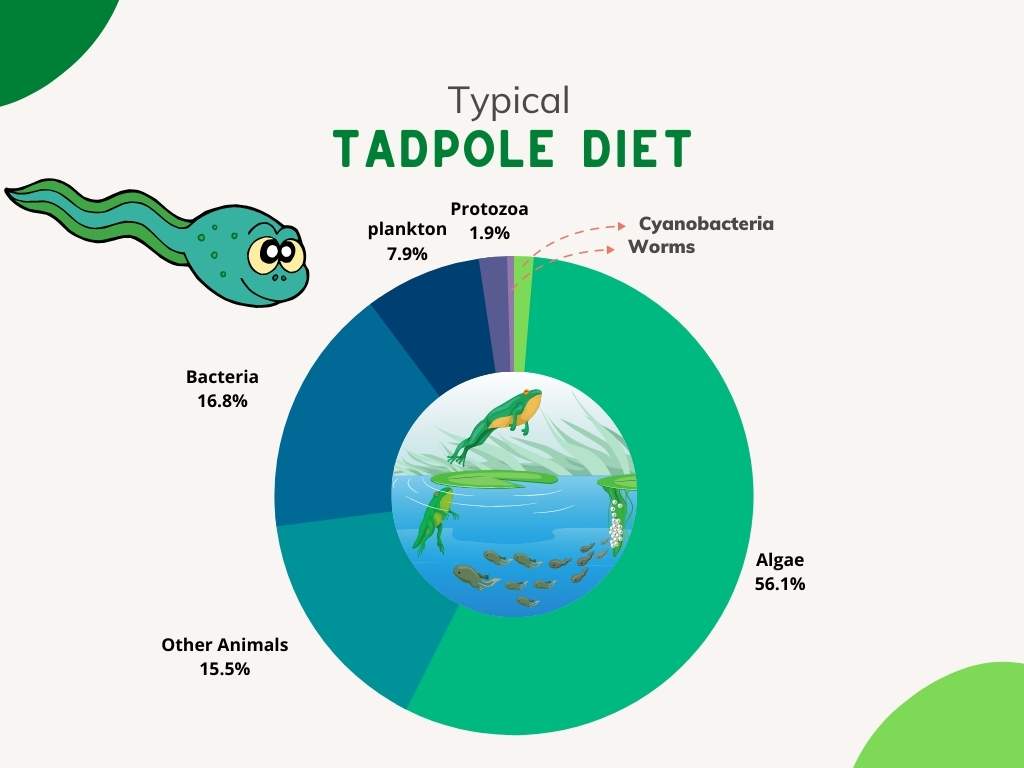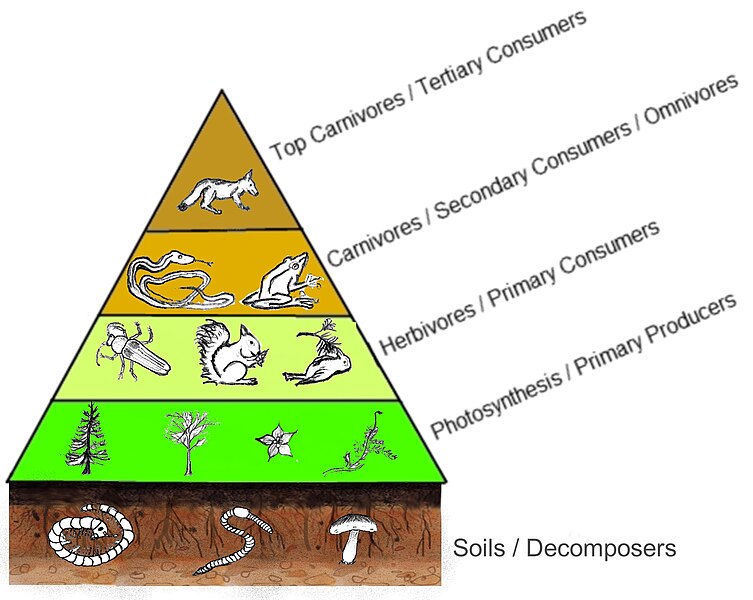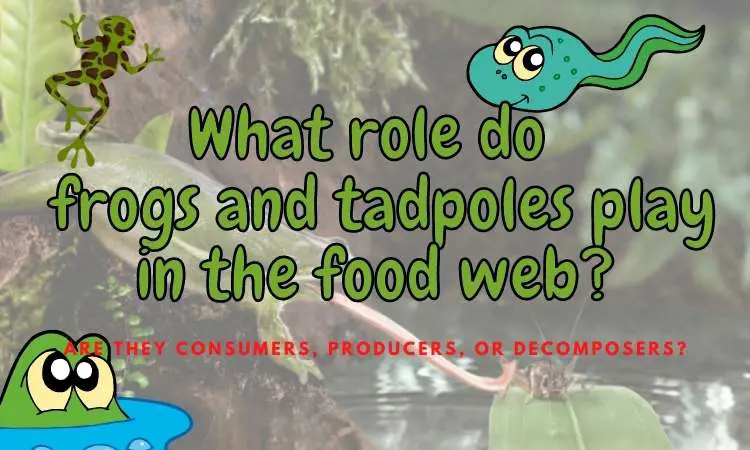A consumer is an organism that eats other living things. Producers produce their own food, while decomposers break down dead things into simpler molecules that can be used by producers.
Frogs and tadpoles are secondary consumers because they eat other living things. Whereas tadpoles eat mostly algae and bacteria, frogs feed mainly on other animals.
Therefore, frogs and tadpoles are not considered decomposers, but primary and secondary consumers depending on the stage in their life.
Is a frog a primary consumer or secondary consumer?
In our ecosystem, producers and consumers have an interrelated relationship. Both need each other to survive. As such, in a food web or a food chain, there are organisms classified as primary consumers or secondary consumers.
Whereas tadpoles are primary consumers, frogs are strictly secondary consumers. Essentially, a frog is categorized as a secondary consumer because it eats other animals.
But first, let us differentiate a primary consumer from a secondary consumer. Primary consumers are animals that consume plants. Simply, they are classified as herbivores. An example of a primary consumer is a grasshopper.
Now, what is a secondary consumer? In a food chain or a food web, secondary consumers are positioned in the second row. Essentially, these are animals that also consume other species of animals.
Simply, they are categorized as carnivores. Examples of secondary consumers are frogs and owls.
More than this, animals can be both classified as primary and secondary consumers. These animals are known as herbivores. An example of an omnivore is a pig. So, to make it clear and accurate, frogs are classified as secondary consumers or carnivores.
Can frogs be decomposers?
A decomposer is an organism that breaks down dead or decaying organic matter into simpler molecules. In other words, they help recycle materials back into the environment.
There are many different types of decomposers, but today we’re going to focus on tadpoles and frogs. These little creatures play a very important role in the ecosystem and are essential for healthy forests and wetlands.
Frogs and tadpoles are not decomposers, as they eat other living things.
Tadpoles do, however, eat decomposer organisms like bacteria, fungi, and protozoa. This helps keep decomposer populations under control, which in turn helps to maintain the health of the frog’s ecosystem. Without decomposers, the ecosystem would become unbalanced and eventually die.

Are any frogs primary consumers?
No, all frogs feed as secondary consumers to some extent, but not all frogs are strictly carnivorous.
For example, one frog species, the Izecksohn’s Brazilian treefrog (Xenohyla truncata), is known to eat fruit as well as insects! This is a truly omnivorous frog that will eat everything from seeds, to fruits, leaves, and insects.

It is the only frog ever known to feed on fruits in the wild!
For example, the green tree frog (genus Hyla) is known to feed on a variety of plant materials, such as fruits, nectar, and pollen, in addition to insects. Some other frog species, particularly those belonging to the family Rhacophoridae, also consume plant matter as a significant part of their diet.
It’s important to note that the specific diet of a frog can vary depending on its species and habitat. While some frogs may primarily consume plants, the majority of frog species are carnivorous, feeding on insects, small invertebrates, and even other frogs.
Can a frog be a producer?
Essentially, frogs are classified as consumers or heterotrophs. Just like other animals, a frog cannot produce its own food and so, it depends on other organisms to survive.
In a food chain or a food web, all organisms have varying roles and positions. Generally, all animals are classified as consumers. As they are heterotrophic and eat other organisms, like plants and animals.
Just like humans, frogs rely on the producers or autotrophic organisms in the food chain for their food consumption.
Animals are positioned in the second level of the food chain, food web, or energy pyramid, which signifies that they are incapable of either making or producing their food.

The relationship between producers and consumers is interrelated to the inner workings of these trophic levels in the ecosystem.
This shows how each organism is related. As frogs are classified as consumers, they need to rely and depend on the organisms classified as producers for them to survive.
Is a frog a decomposer?
Decomposers play an instrumental role in the ecosystem. As energy flows and transfers in each organism, decomposers play a role in breaking apart dead organisms into organic materials which in turn produce the nutrients needed by the primary consumers.
Simply, decomposers eat dead organisms that are left behind in the food chain or the food web. Now, is a frog a decomposer?
To answer this question, it is vital to understand that decomposers are mostly microscopic organisms, but can also be animals such as crabs or crayfish that eat decaying plants and animal matter.
Now, are frogs known to eat decaying matter? No. As such, frogs are not decomposers nor scavengers.
It is an established fact that frogs are categorized as secondary consumers or carnivores. Frogs are not part of the cleanup crew just like those microscopic organisms categorized as decomposers. Frogs serve a different role in the ecosystem.
They are consumers that feed off producers which is integral in their survival. As such, frogs cannot be classified as decomposers. Decomposers are detritivores – feeding off from dead organisms – which, unlike frogs are classified as heterotrophs.
Is a frog a Heterotroph?
Heterotrophs are organisms that are classified as consumers in the food chain or web. Essentially, frogs are heterotrophs because they eat plants and other animals for energy and nutrient consumption.
This word stems from the Greek words which are hetero for “other” and trophe for “nourishment”. In an ecosystem, organisms are divided into two categories: autotrophs and heterotrophs.
Autotrophs are classified as producers because of their capability to make and produce the food needed to sustain nutrients and energy to consumers. Examples of autotrophs are plants, algae, and also other types of bacteria. Now, how do heterotrophs differ from an autotroph?
Heterotrophs are composed of consumers in the food chain or web. These animals are categorized as heterotrophs because they consume and feed off from producers which means that they are incapable of making or producing their own food.
As such, frogs are heterotrophs. Frogs are secondary consumers that consume the primary consumers in the ecosystem. As a heterotroph, a frog cannot be able to make its own food through the process of photosynthesis.
Heterotrophs lack the most important contributing factor in making or producing their food: chlorophyll. This pigment plays a critical role in absorbing the energy from the sunlight which in turn is processed during photosynthesis. As such, frogs are heterotrophs because these animals are made to be consumers in the ecosystem.
What do tadpoles eat?
They eat a lot of primary producers such as algae and cyanobacteria, but also bacteria and smaller animals.
Tadpoles are mainly consumers of microorganisms like algae, plankton, bacteria, and Euglena as well as worms, insects, and their eggs.
Below is a complete list of the Bullfrog tadpole diet:
| Organism name | Percent in diet | Type of organism |
| Spirogyra | 17.98 | Algae |
| Closterium | 16.7 | Bacteria |
| Scenedesmus | 16.07 | Algae |
| Misch. Eggs | 12.46 | Animal |
| Oedogonium | 4.59 | Algae |
| Staurastrum | 3.89 | Algae |
| Euastrum | 3.68 | Algae |
| Pinnularia | 3.45 | plankton |
| Navicula | 3.14 | plankton |
| Staurodesmus | 2.98 | Algae |
| Pediastrum | 2.59 | Algae |
| Euglena | 1.88 | Protozoa |
| Rotifera | 1.54 | Animal |
| Chrococcus | 1.22 | Cyanobacteria |
| Volvox | 1.09 | Algae |
| Dinobryon | 1 | Algae |
| Cosmarium | 0.98 | Algae |
| Zygnema | 0.82 | Algae |
| Asterionella | 0.74 | plankton |
| Calanoida | 0.56 | Animal |
| Nitzchia | 0.49 | plankton |
| Nematoda | 0.45 | Worm |
| Ostracoda | 0.38 | Animal |
| Chironomidae | 0.2 | Insect |
| Cladocera | 0.14 | Animal |
| Acari | 0.08 | Animal |
| Oscillatoria | 0.08 | Cyanobacteria |
| Fish scales | 0.05 | Animal |
| Ancylidae | 0.05 | Snail |
| Amphipoda | 0.01 | Animal |
| Spirulina | 0.01 | Cyanobacteria |
| Other larvae | 0.01 | Worm |
Whereas an adult frog is an amphibian, which means it can live in water and on land, tadpoles only live and eat in the water and therefore mainly have access to the organisms in a freshwater environment.
When small, they eat algae, cyanobacteria, and other microorganisms. As they grow into adult frogs, they eat more and more plant matter and animals such as earthworms, spiders, and all kinds of smaller insects and worms.
Are tadpoles decomposers or consumers?
Tadpoles are consumers just like frogs, but they sometimes come close to being decomposers as they cannot distinguish between dead and living particle matter floating around and may therefore eat dead algae or bacteria, thus effectively functioning as a decomposer.
Conclusion
Frogs are interesting animals when it comes to food habits as they change drastically throughout their lives!
Whereas tadpoles will eat a wide range of microorganisms, algae, and some plant material, frogs mainly eat other animals.
Tadpoles may act as detritivores or decomposers by breaking down decaying plant matter in the water, but they are not true decomposers as bacteria and fungi are.




